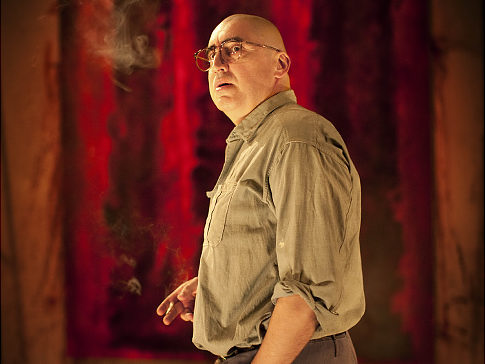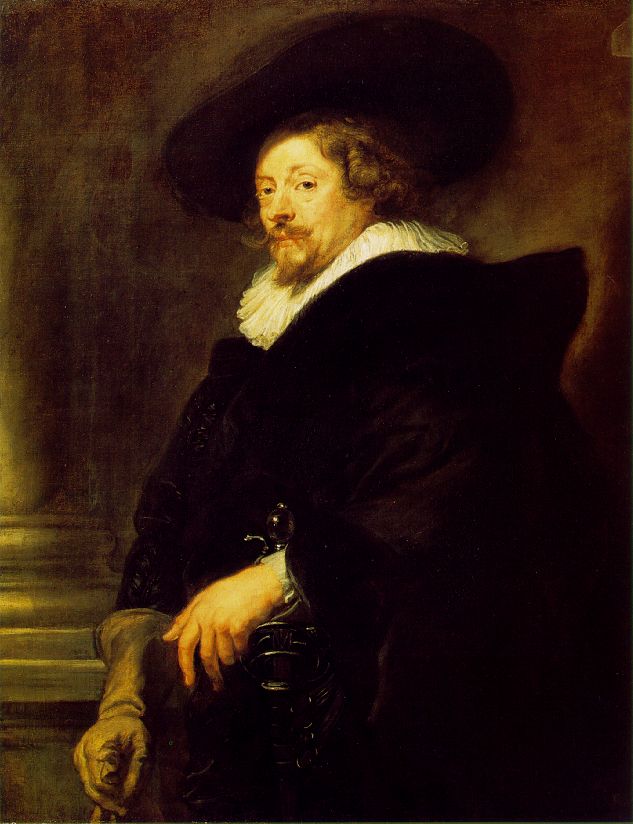
Alfred Molina as Mark Rothko in "Red"
John Logan’s play Red, currently playing at the Golden Theater, New York, centers around a perennial ethical conundrum many successful artists face: whether or not to “sell out” to corporate interests. In the play, Mark Rothko, played by Alfred Molina (you can’t help but wonder if Pollock would have been a more appropriate choice, given his multi-limbed turn as Dr. Octopus in Spider Man 2) battles through the ethics of accepting the Four Seasons commission for the Seagram building in 1959 for a series of mural-sized paintings. Rothko’s quandary, played out through combative and discursive dialogues with his young assistant, has become a modernist parable and yardstick of art’s relationship to the wider society. In the end (spoiler alert!), Rothko turned down the commission after having dinner in the restaurant with his wife (“Anybody who will eat that kind of food for those kind of prices will never look at a painting of mine,” he growled famously, making sure his assistant got the words down right), perhaps having assumed that his works would be visible to office workers rather than the upper echelons of Manhattan society. This seems unlikely, given his apparent intention to create a nightmarish, claustrophobic atmosphere in the paintings, inspired by the unsettling vestibule of Michelangelo’s Laurentian Library in Florence. It’s more probable that his airless, funereal canvases were made as an act of spectacularly ungrateful hand-biting.
Whatever the reason, Rothko did ultimately refuse the commission, offering the majority of his paintings instead to the Tate in London, where nine of them now hang. Their belated redemption – in a public, free museum, where their low-lit installation implicitly evokes a hermetic, sacred space – has secured the artist as a kind of latterday spiritualist, committed entirely to the production of art and not the swelling of his bank balance. With one beady eye on posterity (Rothko was obsessed with his own place in art history, as were many of his fellow Abstract Expressionists), Rothko sought to save himself from accusations of craven commercialism. By refusing the commission, he bought himself a place in a Romantic pantheon alongside Courbet, Michelangelo, and Pollock. Even his death – by his own hand, in a bath, in 1970 – seemed calculated to resonate with art-historical tradition: a bit Marat, a bit Van Gogh.
The relationship between culture and commercialism is an implicit and ongoing subject in our contemporary society of late Romantic yearning for significance. Rock music – the last real bastion of Romanticism, after Warhol made commercialism a fit artistic subject in itself – has been obsessed since its inception with its own authenticity. Popular music’s fixation with authenticity – from hip hop’s disingenuous rallying-cry to “keep it real” while bathed in spangly bling, to Kurt Cobain’s willful rejection of his band’s own popularity and that eternal riposte to populism, “the difficult second album” – is part of its self-definition, whatever it sounds like. So if rock music had, by the late 60s, siphoned off the residue of the 19th century Romantic tradition, where does that leave art now?

Kurt Cobain with daughter Frances Bean
The fact is that the conjoining of art and corporate interests apparently ushered in by Warhol has been (like almost anything ostensibly ushered in by Warhol) greatly exaggerated. Even in his time, contemporaries like Judd and, latterly, Smithson and Heizer – always white and nearly always male – perpetuated a cartoonishly Romantic mistrust of commerce by making works of art that couldn’t be sold – ephemeral, site-specific, geographically isolated large-scale interventions into a landscape. There were, however, always ways to make money on the side, through various kinds of documentation associated with the project. Land art’s apparent anti-commercial bias did what any cultural movement away from the commercial mainstream did – it drove more buyers to it (we’re all 15-year old boys at heart). Much to Cobain’s chagrin, In Utero sold as well as Nevermind. What’s tied up in this is a 19th-century notion of an artist’s ethical purity, that artists are a society’s conscience. Rothko’s conundrum is axiomatic but not isolated.

Peter Paul Rubens, "Self-Portrait," 1639. Vienna, Kunsthistorisches Museum.
The retention of the notion that artists should be against society rather than for it draws the line more definitively between art of our time and that of the past. Whatever superficial connections we’re encouraged to draw between contemporary and historical art, they rarely have much in common. Rothko’s brow-clutching angst would have been laughable to, say, Rubens, who quite happily made aggrandizing portraits of the very wealthy at the same time as producing impassioned visual pleas against war. Corporate sponsorship simply wasn’t a matter for concern before Romanticism made it an issue. Artists in the Renaissance had their works funded by bankers whose portraits they agreed to wedge into religious scenes, even letting them play the Magi if the price was right. This sort of self-aggrandizing patronage was necessary and wasn’t a choice for artists in the 15th century, given the paucity of patronal options. And yet it’s not at all the same thing as corporate patronage now, which leads us on to a very contemporary kerfuffle over contemporary art’s relationship with unethical fiscal power.
Julie Mehretu’s 80-foot-long painting for the lobby of the Goldman Sachs office in New York provides an apt lesson in the ethics of corporate patronage in 2010. Revelations of the investment bank’s misleading mortage investments (which lead Gordon Brown to describe the firm as “morally bankrupt”) had not appeared by the time Mehretu accepted the commission. Interviewed by Calvin Tompkins in The New Yorker recently, the artist made her motives quite clear: this would be her largest commission to date, and would be visible to the public through the glass-fronted lobby (with more than a shade of Rothko’s quasi-socialist aspirations for the Seagram murals). The huge canvas, made in Mehretu’s signature exploded-diagram style, hasn’t been entirely popular with staff (see Courtney Comstock’s blog post here, which berates the painting because it doesn’t even have a title!), but what’s more interesting is Tompkins and Mehretu’s awkward justifications for its existence.
At one point, the author asks the painter if she’d have accepted the commission if the revelations of corporate wrongdoing had been made available to her. “Without hesitation,” she replies. “I don’t see it as an evil institution, but part of the larger system we all participate in.” The virtue of Mehretu’s own work aside, isn’t the point of the unfolding Goldman Sachs scandal that it was operating outside of “the larger system” of corporate ethical responsibility? In reference to artist’s acceptance of commissions from ethically dubious patrons, Tompkins whimsically concludes: “Fair enough, I guess. If art were judged by the company it keeps, much of the High Renaissance would go down the drain.” Which isn’t an honest comparison, given the limited range of available patrons during the Renaissance due to a more or less feudal economic system. It simply wouldn’t have occurred to artists such as Raphael or Titian that the conditions of their practice had ethical repercussions. That’s what artmaking was then.

Julie Mehretu
Is it reasonable to berate Mehretu for her acceptance of the commission? On the one hand, it’s a bit adolescent to take a finger-wagging position on “sell-outs.” It’s not as though corporate interests don’t dominate both public and private institutions, from UBS’s extensive funding of the rehang of Tate Modern to the Letrasetted lists of corporate funders on every museum wall in the world. On the other, residual Romantic reservations about the overt capitulation to corporate interests generate a queasy aftertaste, especially given Goldman Sachs’ unspooling ethical wrongdoings. It’s hard not to see Mehretu’s mural as backdrop to and symbol of the unraveling of unchecked greed, as it became last week on a Huffington Post page accompanying further revelations – those whirling, dismantling blocks and curves are almost embarrassingly prescient and metaphorical. Maybe it’s inappropriate to look back at Rothko’s “bodacious kernels of windbaggery,” as Stephanie Zacharek brilliantly put it, but there’s something about the artist’s genuine anxiety over his art’s function in the world – however pompously or portentously put – that provides an historical corrective to the sometimes ethically confused world of contemporary art.



